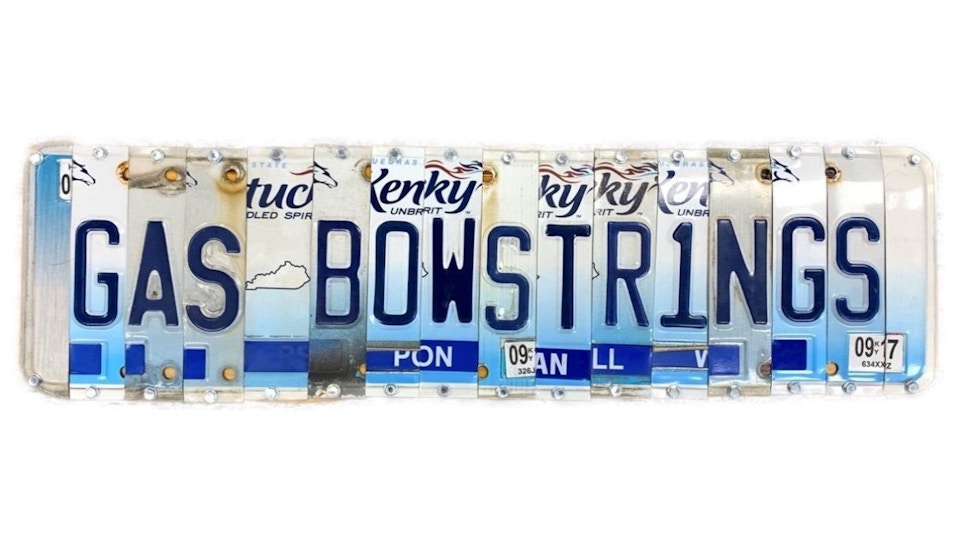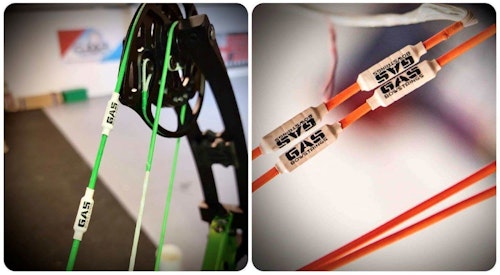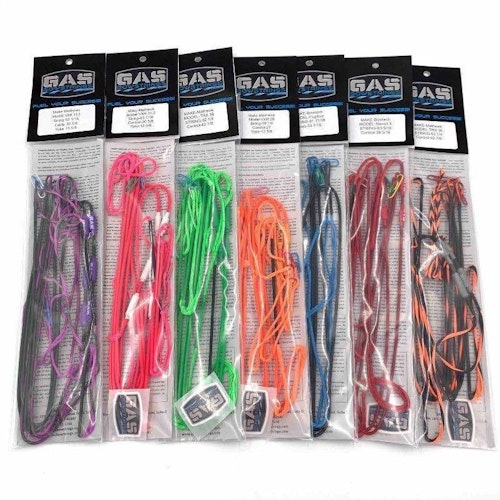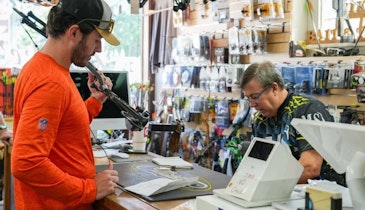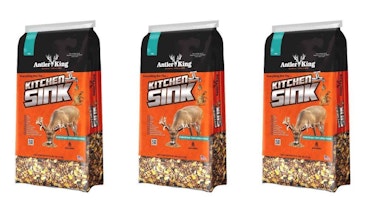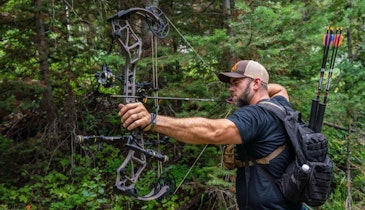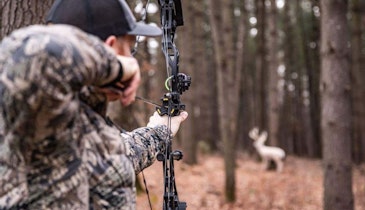Years ago bowstrings were made with plant or animal fibers, which at the time were the only things available. They were crude but, at the time, effective enough to get the job done. Today’s bowstrings are highly technical components of the bow, designed to handle the explosive power of bow and crossbow limbs releasing their energy to send an arrow flying.
GAS Bowstrings (www.gasbowstrings.com) of Clay City, Kentucky, was founded five years ago by bowhunters and competitive shooters. They’ve been in the field and on the target line, and know what hunters and shooters want and need. Archery Business talked with GAS Bowstrings President Eric Griggs for this month’s “In the Spotlight” column.
AB: Thanks for taking the time to speak with Archery Business and our readers. Can you tell us a little bit about your company?
EG: GAS Bowstrings is a family owned and operated business. We started the company in 2017 with just three of us and have quickly grown GAS Bowstrings into the largest aftermarket string company in the industry. We are committed to building the best performing aftermarket strings on the planet, while providing industry leading customer service.
AB: You’re located in Kentucky, a big state for hunting and bowhunting whitetail deer. Do you and your team hunt, and if so how does that in-field experience help you with GAS Bowstrings?
EG: Yes! I’m a longtime archer and bowhunter. More than half of our team members here also bowhunt or shoot competitively. Even the ones who don’t bowhunt, most of them do some sort of hunting and fishing, or have a spouse/family member who does. It’s almost sort of a prerequisite to be a part of our team. The sense of pride that one has, being an end user of the product, is invaluable. When a string-maker understands the importance of quality because he or she uses the products we build, in the field, it bridges a huge gap and really connects the team member to what we do.
AB: How about competitive and 3-D target shooting? That continues to be a big part of the archery industry, as well. Do you see it remaining significant going forward?
EG: I really do. A large part of our customer base comes from the competitive, target archery world. Archery is an amazing sport and seeing the growth is very rewarding. I’ve been doing this a long time and have seen some different trends on the competition side of the sport. Great growth in some areas and unfortunately, you see some decline in a few others, but it all seems to be moving in a great direction right now as a whole.

AB: How did you get into the archery business? Tell us a little about your background.
EG: I’m basically a lifelong archer. My father introduced me to the sport as a kid, and I’ve loved it ever since. I guess I’ve always been somewhat entrepreneurial, as my first job as a teenager was building custom bowstrings for local archery shops back in the 1990s. I also started competing at a young age and was successful as an amateur archer. I went on to compete as a professional archer, and it was through those relationships with sponsors and collaborating on some product designs that opened some doors for me to work in the industry. I’ve done everything from working in a pro shop to managing sales and marketing, product design, operations, executive leadership and now business ownership. I’ve been very fortunate to work with and learn from some great people over the years who have brought me to where I am today.
AB: What early successes or failures were beneficial to you for continued success?
EG: I guess I’d say a little bit of both. Learning to win is important. It’s a mentality that crosses over to all aspects of life and business. Even if you have early success, I think you need to bloody your nose a few times before you can truly understand or appreciate that success. The past teaches us many lessons and you can create the best road map to success, but you still must know where the land mines are. I’ve been very fortunate to have worked for some great mentors who led me to the right decisions, but also let me bloody my own nose a few times along the way. I think those are the lessons that shape us for long-term and continued success.
AB: Dealers have a wide selection of archery products to choose from to show and sell to customers. Why should they choose GAS Bowstrings for their shop?
EG: There are several great string manufacturers out there. We understand we aren’t the only ones who do what we do, but it’s always our goal to be the best vendor partner we can be for our dealers. This means checking all the boxes! Providing great quality products, reasonable shipping times, good dealer margins and exceptional customer service. In addition, we create a consumer demand for our product, so their customers come in asking for GAS by name. These are all important aspects of being a good partner. In addition, we go to great extents to protect the brand value of our strings and the dealer. We are a very dealer-centric business and try to drive the consumer back through to the dealer any chance we get. For this reason, you won’t see GAS running sales or specials online. No Labor Day sales, 4th of July specials, Black Friday sales, etc. We understand that our success is dependent on the success of our dealer partners, and we simply don’t take that for granted.
AB: Can you describe, without giving away secrets, the Total Tensioning System and how a dealer can explain that to customers without sounding like PR-speak? Shooters definitely want to know about how strings are stable and have no creep, peep rotation or serving separation.
EG: The Total Tensioning System is a complete approach to how we build our strings. Strand equalization and stability in the string bundles is really the holy grail of string building. Most string makers try to put a lot of time into simply pre-stretching (tensioning, “pre-cycling”, etc.) when the true “secret” is getting down to the individual strand level from the very moment the string is being built. We take a far more in-depth approach to fiber tensioning, and we’ve even developed specialized equipment for our specific process that provides extensive tensioning in various stages of the construction of the string.
AB: Your website states: “Perfection in bowstrings is nearly unobtainable, but we strive to be better and continue to solve problems.” It’s rare to hear a company not say a product is perfect, but that’s refreshing. Has this honesty and transparency helped you when dealing with buyers, business owners and shooters?
EG: I believe in extreme transparency. There are so many factors that go into string building that create challenges, but we work to overcome those challenges and build the absolute best products that can be built. I’m also a big believer in continuous improvement. Many people often default to assumptions that as the company grows bigger, the quality automatically goes down. There always will be growing pains, but our commitment is to always be better. Be better today than we were a year ago, and in a year from now to be better than we are today. We invest so much into our process, training, and the quality control of our strings.
We have a crew of incredibly talented string-makers who are experts of their craft and have the open forum to make suggestions for improvement. I might have 30-plus years of experience, but these professionals do this every day, and if there’s even a small change we can make to improve our product, we encourage these ideas to be brought forward. We also have a total accountability culture at GAS, meaning every piece we build is tied to the string-builder who built it. Every bowstring set has its own build form and the string-builder signs each sheet. We can take a set of strings we sent out two years ago and tell you who the string-builders were who built it and who QC’d it. Everyone who works here understands the importance of quality and equally understands they’re accountable for their quality of work.
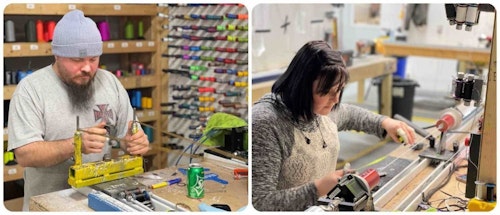
AB: I’m a dealer you meet in a casual setting. Give me your best elevator pitch that makes me want to know more.
EG: I’d shift that back to a question: How can GAS Bowstrings help your business become more successful? That’s really it at the end of the day. Like I mentioned before, I believe we make the best product, but every company out there is going to tell you that. To the consumer, we are selling our product. To the dealer, we are still selling our product, but more importantly, our partnership. Checking all the boxes for our dealer partners is what it’s all about.
AB: Compound bows still drive the train but crossbows are gaining. What interest are you seeing in crossbow strings and cables from dealers or shooters?
EG: It’s huge! Crossbow use has grown exponentially and gained massive popularity in most regions of the United States. As the demand for crossbows grows, so does the need for replacement crossbow strings. We’ve seen huge increases in the amount of crossbow string sales in just the last couple years. During October and November, crossbow string sales are more than 25 percent of our overall business.
AB: One thing you provide is colored bowstrings. Does that continue to grow in interest as new or younger shooters want to customize their compound or crossbow?
EG: Customization is always one of the great drivers of aftermarket string sales. People love the ability to choose their string colors, serving colors and now even the colors of the heat shrink over the speed nocks. Something we just started doing this year was offering custom text on the speed nocks as well, which opens a whole new level of customization.
AB: Have you survived the pandemic and supply chain situations without big issues? Securing materials has been tough for some industries, but it seems the archery industry has chugged along pretty well.
EG: Yes. The supply chain issues for us have been very minimal. BCY Fibers is our sole supplier of string material and they’ve been amazing to work with. We’ve had to be creative with a few other things, but all in all, I feel like our industry has been fortunate compared to others.
AB: Do you work with dealers on competitive pricing, sales or specials? If so, tell us a little about that.
EG: For the archery dealers, it’s no secret they must make money to survive, and string replacements can be a major source of revenue for most shops. Our goal is to provide our dealers very healthy margins with our strings, while maintaining the retail value of our product in the market. Between the profit margins available on strings, combined with the service fee for installation, bowstrings should be a large profit center for dealers. We put more focus on making sure that this is a constant, year-round.
AB: Thanks again for taking the time to talk with Archery Business this month. Is there anything else you’d like dealers to know about Gas Bowstrings?
EG: I think we pretty much covered it. I’m super passionate about this sport, and I could go on for days. I appreciate the opportunity to chat with Archery Business!
